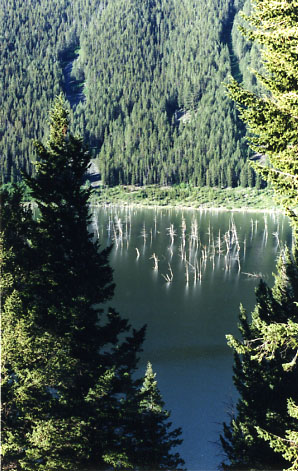1959 was a monumental year!
First, I was born, then within 6-weeks, Earthquake Lake was born.
It took 53 years later before I first laid eyes on this lake that was born on August 17, 1959 in the Yellowstone area of Montana. Just south of me, on the way to Yellowstone National Park, if you are going into the west entrance, you will land in the town of West Yellowstone. This town is mainly a stopping point before heading into the park, but it is a old town with a lot of interesting history and buildings.
Enroute to West Yellowstone, you follow 191 from Bozeman as it winds along the beautiful Gallatin River deep into the Gallatin Forest. As you climb out of the canyon and to the crest of the pass, you dance with the Montana and Wyoming borders and peak over a large valley that is home to a tiny rural community that lives at the branch of 191 and 287 West.
A swing to the right will take you to one of the local examples of what can happen when Yellowstone has something to say.
A 7.5 quake hit the area of this valley where it sent the sides of Sheep Mountain on a 100 mile per hour journey down the side of the mountain and into the canyon where it blocked water from the Madison River and damaged the Hebgen Lake dam. The quake killed 28 people who were camping on the Hebgen Lake and the Madison River camping areas and upset the geysers and other geothermal activity within Yellowstone National Park, which were miles and miles away. Over 80 million tons of debris came crashing down the mountainside in less than a minute.
The disruption of the flow from the lake, caused the Madison River to divert itself naturally, which helped to create Earthquake Lake – or as known by the locals, Quake Lake. This lake is 6-miles long and 190 feet deep. The quake caused the floor of Hebgen Lake to drop over 20 feet.
The quake was the most powerful to hit Montana in recent history.
The highway winds around the banks of the new lake, but the old highway stops right at the edge of the newly minted lake.
Here is the photo from the USGS that shows the flow of rock down into the valley area

You can see how it flowed down the hill and ended up in the bottom of the valley. The lake is the newly formed Quake Lake.
The tops of the trees can still be seen in this photo taken from the overlook.

You can read more about the history of Quake Lake and interesting facts by going to this page in the Gallatin National Forest
http://www.fs.usda.gov/detail/gallatin/specialplaces/?cid=stelprdb5127785
I have not been in the visitor’s center, but I was told that the basement is home to seismic equipment that continually monitor the movement in the area. The seismic activity in this entire region is active and one stop to the USGS’s Earthquake Tracker site will have you staring at amazement at all the activity that is going on worldwide.
Here is the latest just around Yellowstone in the last few days of this writing.
Click the map to go to the USGS site and see what is rattling in your neighborhood.
Julie and Blu
